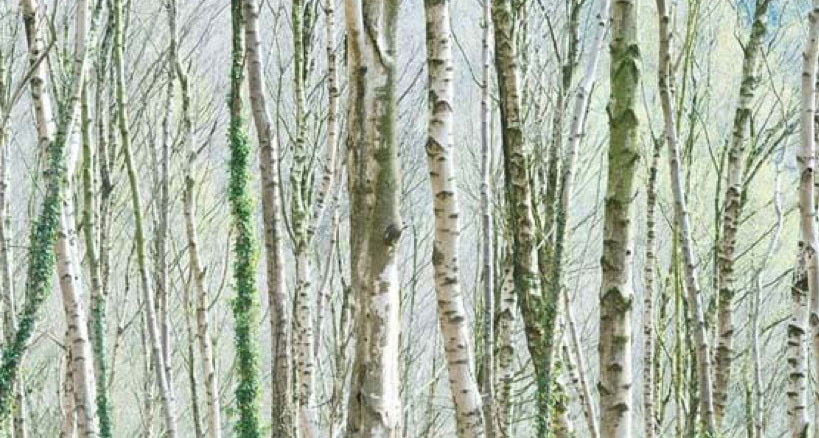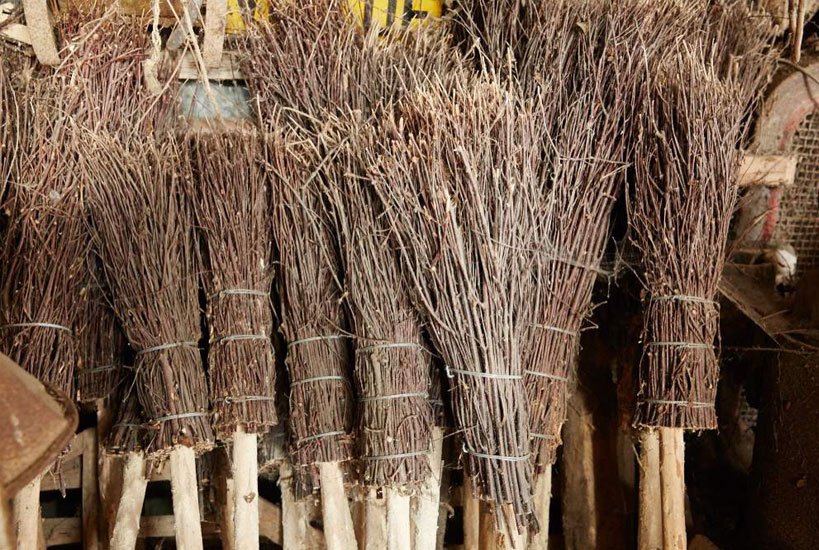Birch trees are the most common native trees found in Scotland, and are widely found in the Tayside region. There are two species of birch tree in Scotland, but the silver birch is the most commonly found and is easily recognisable thanks to its distinctive bark which is silvery white with black marks, and has a paper-like texture. They have slender trunks, and can reach a height of up to 30 meters. They have a relatively short life span in comparison to some other trees, and generally live for between 60 and 90 years.
Birch trees are the most common native trees in Scotland and are widespread across the country. There are two species of birch tree found in Scotland – the Silver Birch (Betula pendula) which is widely found throughout Tayside, and the Downy Birch (Betula pubescens) which prefers wetter soils and is more common in the west of the country. They are a fast-growing, pioneer species of tree – meaning that they will readily grow on and colonise open ground. They can be found in established forests amongst other species of tree like pine and oak, as well as in grouping alone known as birchwoods.

Birch trees have a wide variety of uses, and different parts of the tree can be used in different ways:
The wood from birch trees is pale creamy white in colour and smooth with a subtle, straight grain. The timber from birch trees is a hardwood and is suitable for bespoke furniture making, flooring and using as a building material, but the slender trunks (which rarely grow larger than 40cm) mean it is often used to produce plywood.
It can also be used to make smaller objects such as brush backs and toys, and is easily turned and carved making it ideal for hand crafted spoons, bowls and vessels.
Birch trees have a distinctive paper like bark that can be peeled off without harming the tree. The bark is surprisingly pliable and can be cut into strips and used to weave baskets and containers. Birch bark also contains a compound called betulin which has antibacterial and antifungal properties, and salicylins (also found in willow bark) which are anti-inflammatory.
The twigs from birch trees can also be used for weaving, and were traditionally used to create brooms and brushes for use in the home and garden called besom brooms – what might be thought of as the archetypal ‘witches broomstick’. You might not find many besom brooms in contemporary homes, but they are still in production within the UK.

Birch trees are deciduous and produce leaves between April and October. The young leaves can be harvested and used as a natural dye which has an acid yellow hue, and leaves can also be used to make a bitter tea or tincture which is traditionally believed to have medicinal, anti-inflammatory properties.
For approximately 3 weeks in early spring it is possible to tap and collect the sap from birch trees. This can be drunk as is, or fermented to create birch wine or turned into syrup. In Tayside, a company called Birkentree collects birch water from trees in Perthshire which then bottle and sell across Scotland.
Although not a product of the birch tree directly, the Chaga Mushroom also has a crucial relationship with the birch tree. It is a parasitic fungus that grows on the tree’s trunk that can be harvested and is thought to have many potential medicinal and wellbeing uses.
Unfortunately, precise data relating specifically to the production of birch timber in Scotland is not currently available.
Birch trees are a pioneer species of tree – meaning that they will readily grow on and colonise open ground. They fulfil an important role in the ecosystem of forests as they can be used to improve soil quality, which in turn helps to support other species. They have roots that are deep and widely spread which helps them to draw up nutrients that would otherwise be inaccessible. Some of these nutrients then get recycled and returned to the soil’s surface in autumn each year when the leaves fall and decompose. This then makes the environment more hospitable for other species of trees. They are fast growing, hardy, and produce a strong wood. They also support around 334 known insect species, and have important (often symbiotic) relationships with multiple fungi.
Birch wood is a renewable and sustainable material that grows readily and easily within Scotland and there is an abundant supply, although the trees here don’t grow as large as some of their counterparts in other Northern European countries which means they don’t produce as much timber. A lot of birch timber commercially available is imported, but it is possible to buy wood from birch grown in Scotland from suppliers such as Scottish Wood. They are a sawmill based in Fife who sustainably source all their timber locally, usually within a 50 mile radius of their location in Fife. Operating as a not for profit organisation, the funds raised from the sale of their timber goes directly to supporting projects that promote the sustainable development of woodland resources in Scotland. Additionally, a report by Forestry Scotland has shown that domestic birch woodlands are more than capable of yielding high quality timber with the correct planning and management.
Timber is one of the only renewable construction and building materials, and a resource that can be replenished and expanded through sustainable forestry and woodland management. When the wood reaches the end of its life cycle it can be reprocessed as wood chip, or used as biomass for energy generation.
Scotland has a native Celtic language called Gaelic which has 18 letters in the alphabet. Traditionally, each of these letters was based on a different tree. And two of these letters are named after birch trees!
B – is Birch – Beith (pronounced “bay”) in Gaelic
P is Downy Birch – Peith bhog ( pronounced “pay voh-k”) in Gaelic
“Birch”. Trees for Life, https://treesforlife.org.uk/into-the-forest/trees-plants-animals/trees/birch/. Accessed 27 January 2021.
“Silver Birch”. Forestry and Land Scotland, https://forestryandland.gov.scot/learn/trees/silver-birch. Accessed 27 January 2021.
“A-Z British Trees: Silver Birch”, Woodland Trust, https://www.woodlandtrust.org.uk/trees-woods-and-wildlife/british-trees/a-z-of-british-trees/silver-birch/. Accessed 27 January 2021.
Architecture & Design Scotland. “Scottish Birch”, Material Considerations: A Library of Sustainable Building Materials, https://materials.ads.org.uk/scottish-birch/. Accessed 27 January 2021.
Finch, Stephen. “Native Hardwoods”. Stephen Finch – Furniture Maker, http://www.stephenfinch.co.uk/materials. Accessed 27 January 2021.
Martynoga, Fi (editor). A Handbook of Scotland’s Wild Harvests, Saraband, 2015.
Forestry Commission Scotland. “The Gaelic Alphabet Through Trees”. Outdoor and Woodland Learning Scotland, https://www.owlscotland.org//images/uploads/resources/files/AlpahbetPoster1Gaelic.pdf. Accessed 27 January 2021.
Price, Andrew and MacDonald, Elspeth. “Growing Birch in Scotland for High Quality Timber”, Scottish Forestry, https://forestry.gov.scot/publications/347-growing-birch-in-scotland-for-higher-quality-timber/viewdocument. Accessed 28 January 2021.